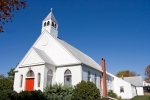July 2012
Communications: Tried, True, & New
Newsletter Makeover
We’re all familiar with Alice’s Adventures in Wonderland, where every curious critter has its own take on logic and language. It’s not a lot different from the current environment for communications. A little more than a decade into this 21st century, we face a communications wonderland, where social media’s the rage and everyone’s atwitter over, yes, Twitter, Facebook, YouTube, blogs, e-zines, Internet advertising, streaming and mobile technology. It may not be Lewis Carroll’s Wonderland, but church leaders and communicators can feel like the White Rabbit, Oh dear! Oh dear! I shall be late!
Incorporating new technologies challenges us to rethink and refresh some “tried and true” venues like one of my favorites — the parish newsletter.
What Use Is A Parish Newsletter These Days?
Not so long ago, the newsletter was the main way to make sure your congregation knew when you switched to the summer schedule, where volunteer help was needed, when Sunday School resumed, and how to sign up for the latest adult education class. Published weekly, twice a month, or monthly, its main purpose was information, supplemented with a little teaching and inspiration from the rector and maybe a few photos for interest.
These days, websites, e-news, mobile apps, and Facebook, working together, relieve a good deal of that pressure, freeing the newsletter to share more of the stories and life of the congregation. And the life we share in our churches should be shared to help build up the community and draw others in. Additionally, a church newsletter with well-written stories and photos creates a vibrant record of a congregation’s history-in-the-making.
Freeing the newsletter from the demands of the calendar means that you can go for quality over quantity. Some churches, like All Saints’ Beverly Hills, St. Stephen’s Richmond, and the New River Regional Ministry in southeast Florida have moved to vibrant quarterly publications packed with stories that are widely read and enjoyed by the members of their congregations.
A Few Things That Matter
Start with a plan Gather a group of people to brainstorm each issue. You need input from staff and a few people with wide knowledge and involvement in the parish. Consider what’s coming up that needs fuller explanation and what has happened that would make a good story. Look at each aspect of your church’s life — worship, children and youth, adult education and formation, outreach, music, community life, groups, new member welcome, stewardship. Something significant is going on in every one of those areas. It can be a big as a new program for adult education or as simple as one person’s story about finding her way to the church or an interview with a volunteer.
Create a list of stories for the upcoming issue. Include notices and other brief announcements. Leave room for the last-minute items forgotten in this planning go-round. Counting back from the date you want the issue to mail or post online, figure out deadlines — one for writers, one the editing/layout process, and one for production.
Let many voices be heard — and edited Story list in hand, identify parishioners who are willing to write about their experiences teaching Sunday School, cooking for people who are homeless, figuring out a stewardship pledge, receiving the prayer and care of the community, growing up in the parish, sharing their faith. (Let the rector’s voice be heard, too, of course.) Parish life is rich and never lacks for stories.
Talk with your writers about what you want and give them a word count. Make sure they understand that pieces will be edited for length and clarity. Today’s readers are extremely busy, often distracted, and maybe not quite engaged. It’s important give your volunteer or staff editor time to make sure each article is lively, welcoming, clear, and relatively brief.
Tell the truth with simplicity Like all disciplines, the church has it’s own vocabulary. Words like narthex, west end, the PB, confuse newcomers and can make them feel unwelcome. Complex theological language is likewise perplexing and can be off-putting. We all need to find ways to talk about faith and our life together that are accessible to seekers and skeptics, and to avoid the insider talk that says, “If you don’t get this, you don’t belong.”
Design and production matter The invention of movable type and development of typefaces in the centuries following, to say nothing of the recent explosion in digital typefaces, means that the type toolbox is overflowing. Good design, however, is always about simplicity, readability, and space. Like editing, it’s about whether the eye and the mind are encouraged to linger or sent away in search of something more inviting.
So as with language, keep design simple — one or at most two typefaces, some white space to let the page breathe, a little color here and there but not too much, good photos large enough to have some impact, a standard layout that’s flexible enough to permit some interest. (I’m fond of a three-columns for that reason.)
Whether you do a full print run or publish mainly online with a short supplemental printing, use a paper with some heft and a finish that enhances the layout and design. Many people — staff and volunteer writers, editors and photographers — have a hand in your newsletter. Doing it well honors their contributions and reflects our mission to do all things for nothing less than the glory of God.
Print or digital — why not both? In the lean times many churches face, it’s tempting to whack away at print production and mailing costs. But a nicely written, well-designed and produced newsletter with articles and photos reflecting a church’s shared faith and life is almost as good as a letter (remember letters?). A welcome sight amidst the catalogues, bills, and solicitations that make up the rest of the week’s mail, it will wait patiently for time to read it. Visitors and friends stopping by may see it, extending its reach beyond the member’s household.
Once the print piece is finished and mailed, it’s simple to create a PDF of the issue and post it on the website for parishioners who prefer that to paper and visitors exploring church via the web, making it doubly useful. Extra copies in the parish office, library, and welcome table extend its reach further.
It Should be Fun
If creating each issue of your newsletter is just another grim task, it will fail its mission to reflect the meaning and joy of our life together as Christians. That doesn’t mean that producing it is a laugh a minute. It’s work. But finding ways to give people time for their task, to thank them, to take delight in collaboration and the finished piece are important. We’re publishing glad tidings, and there is joy in that.
Time and Money
In a time when members are struggling and your church may be confronting reduced pledging, communications is more important than ever. Up-to-date, accurate, welcoming communications in all areas — from signage to bulletin, newsletter, website, and other web-based media — encourage and strengthen your community and invite others into your life and faith.
A strong parish newsletter plays an important role in both parishes with simple communications and places that have leaped headlong into our 21st-century wonderland. No other regular publication captures the flow of the church’s life with as much breadth and care. It takes a good deal of staff and volunteer time to produce even four issues a year, and it may seem impossible. But as the White Queen told Alice in Through the Looking Glass, “Why, sometimes I've believed as many as six impossible things before breakfast.”
Go for it.
Susan Elliott is a writer, editor, and graphic designer, working mainly in faith-based communications. Director of Communications at St. Columba’s Episcopal Church in Washington, DC, for 21 years, she has been a freelance consultant since 2008. She has worked with the Cathedral Congregation and the Cathedral Choral Society at Washington National Cathedral, the Alban Institute's Congregational Resources Guide (CRG), All Saints' Episcopal Church, Beverly Hills, Forward Movement, and the Evangelical Education Society of the Episcopal Church (EES). She collaborates with the Rev. Jay Sidebotham on "Slow down. Quiet. It's Advent!" published annually by Church Publishing, Inc.
Resources
- 5 Tools Church Designers Need: Teamwork http://www.churchmarketingsucks.com/2010/04/5-tools-church-designers-need-teamwork/
- Michael Cina Creativity Catch Up Clip Art http://www.churchmarketingsucks.com/2011/02/michael-cina-creativity-catch-up-clip-art
- Who Should do your Writing http://www.churchmarketingsucks.com/2012/03/who-should-do-your-writing/
- Copy Matters: Benefits not features http://www.churchmarketingsucks.com/2012/03/copy-matters-benefits-not-features/
- Reaching the Unplugged http://www.churchmarketingsucks.com/2012/06/reaching-the-unplugged/#comment-34202
For downloadable PDFs of the newsletters mentioned in the article, please see:
- Seasons of the Spirit, published by St. Stephen's, Richmond, Virginia: http://saintstephensrichmond.net/communication#PDFSpirit
- All Saints' Life, published by All Saints', Beverly Hills: http://www.allsaintsbh.org/publications.html
- New River Current, published by All Saints Episcopal Church, Saint Ambrose Episcopal Church and Centro Hispano de Todos los Santos, Fort Lauderdale: http://www.allsaintsfl.org/






